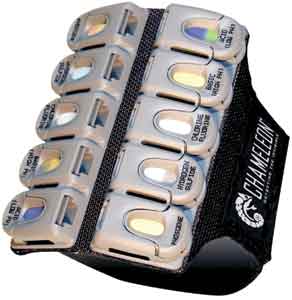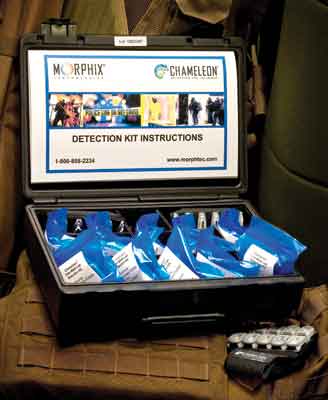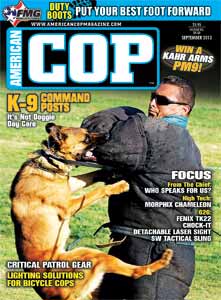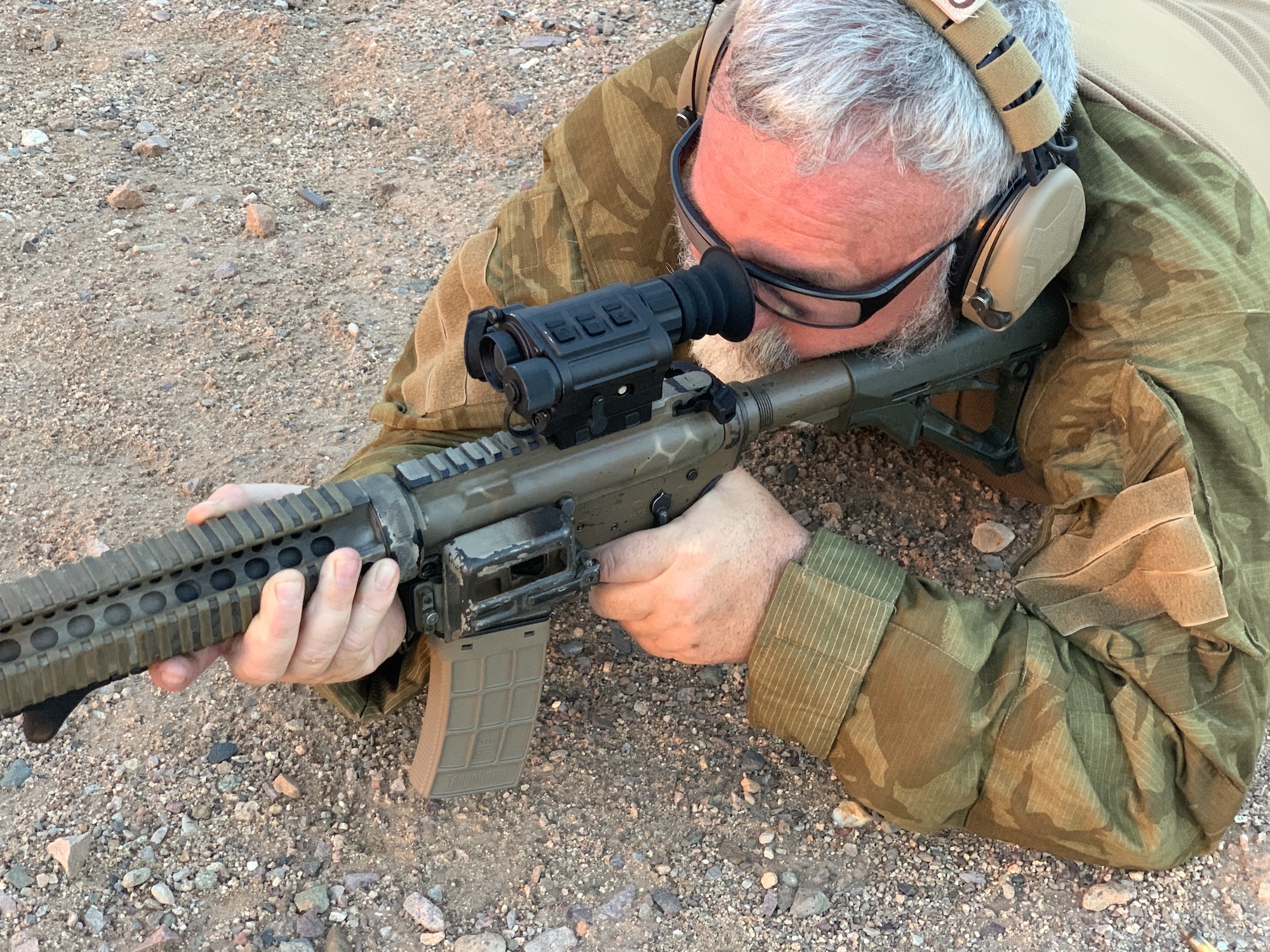
HT_1
Keeping Away From The Methyl-Ethly-Bad-Stuff.
he last few decades have brought about a demand for more and more chemicals; along with that demand is the necessity to protect our first responders. Who’s the first to respond to the scene of a traffic accident, train derailment, factory explosion or even some crazy dude holding a bucket of who-knows-what? Right, it’s us.
The 2007 Commodity Flow Survey released in 2010 by the US Department of Transportation estimated 2.2 billion tons of hazardous materials are carried by all modes of transportation throughout the US. That represents 1.5 trillion dollars of product. More than half of the hazardous material tonnage (54 percent) is moved via trucks over our highways. The next greatest amount, 28.5 percent, is carried by pipeline. Chances are if you’re on the road, you’ll run into this stuff at some point.
Today, when conducting an illegal drug lab investigation or raid, there’s as equal a threat level from that environment as from the near toothless and organically psychotic tweaker cooking the stuff. Now we need to protect ourselves and our partners not only from the druggies engaging in a firefight, but also from mechanical booby traps, IEDs and the chemicals used to create the poison.
Proactively Mitigate Danger
It’s what we do — if we know about it. Some of the most dangerous threats, like toxic airborne chemicals, are often unseen. We tend to look for the bad guy. If you’re investigating a potential chemical suicide, responding to an overturned tractor-trailer on the interstate or raiding a meth lab, safe breathing is paramount to all involved.
The Chameleon from Morphix Technologies was designed for just this kind of threat. The traditional electronic chemical detection devices used by the military and handed down to law enforcement require a lot of training and regular maintenance; these devices can be a budget-buster for most jurisdictions. The Chameleon is more convenient, easy to use and the cost is manageable.
The Chameleon is a wearable, configurable sensor designed for an easy fit on your forearm. It’s worn over your uniform, tactical gear or level-A suit. The sensor tray attaches to the armband with hook and loop material. There are ten plastic housings for the sensor cassettes, and you can load up all ten housings with different sensor cassettes or just one or two depending on the threat. Chameleon’s color-change alert system is simple: one color on a sensor cassette indicates the absence of toxic gas, but when two colors appear in the Chameleon’s cassette window, it’s time to do something — like get the hell out of there.
The sensors change color when toxic gases are present, and require no power source or calibration. The system is designed to military standards for use in a wide variety of operating environments. It can be used in desert heat, arctic cold or tropical conditions. It can even be immersed in water. Just shake the water out of the sensor cassette window and continue your mission.
The Chameleon detects gases and vapors in the air where other technologies only detect hazards in liquid or aerosol form. Gaseous forms of toxic chemicals are your most likely danger source. And, the sensor cassettes activate at 50 percent of what would become a dangerous dose.
The Morphix kits are easy to use, and can make your life easier. You don’t need a chemical engineering degree to decide which cassette you need to place in the sensor tray, how to operate things or how to read it. They’re cop-proof at every level!
Prepared Kits
You don’t need to be a chemical engineer to figure out which cassettes to use for given situations. Morphix offers kits for a variety of situations. Each kit includes a 14″ and an 18″ armband and the appropriate chemical detection cassettes for certain situations.
The Chameleon HazMat Detection Kit can be used in a wide variety of HazMat incidents — anything from a chemical spill, industrial accident or train derailment, to a chemical suicide, possible terrorist attack or just an unknown substance along the road. It contains cassettes for Chlorine/Fluorine, Hydrogen Fluoride, high pH, Hydrazine, Hydrogen Sulfide, Iodine, low pH, Phosgene, Phosphine and Sulfur Dioxide.
The arson kit contains cassettes for Ammonia, Hydrogen Cyanide, Hydrogen Fluoride, Hydrogen Sulfide, Nitrogen Dioxide, low pH, Phosgene and Sulfur Dioxide. The clandestine meth lab kit detects Ammonia, Hydrogen Sulfide, Iodine, low pH and Phosphine.
Chemical suicides were first documented in Japan in 2008, where they’re known as detergent suicide. In 2008 a chemical suicide by a young girl sickened over 90 people — many were the first responders. Everyday household cleaning chemicals are mixed in an enclosed space like a laundry room, closet or inside a closed car, causing poisonous and lethal gas to be released. Since then, over 2,000 cases have occurred in Japan, and it’s become a very popular means to a permanent end.
So, you’re not patrolling the mean streets of Kobe or Yokohama, why worry? It’s happening here now — that’s why. Over 72 cases in the last 3 years have been documented in the US — 36 in 2010 and 27 between January and June 2011, according to the most recent reports.
Morphix, in response to this growing threat, has developed a chemical suicide kit. It contains sensor cassettes that detect high pH, Hydrogen Sulfide, low pH, Phosphine and Sulfur Dioxide.
Normal Patrol = Oxymoron
The only thing certain about patrol is it’s never normal. You can go from sitting in the patrol car swilling coffee to driving 100 mph faster than you can say, “What the %$&* was that?” There are so many variables to encounter, the term “a standard patrol shift” means be ready for absolutely anything — from taking a burglary report to responding to an asteroid strike. The threat of encountering Methyl-Ethyl-Bad-Stuff, commonly known as HazMat materials, is very real and an everyday occurrence.
We can’t go about our “normal patrol” duties wearing a HazMat suit for protection. But we can use technology to give us a little bit more of an edge — and to make sure we come home after shift not glowing in the dark. Unless you already do, that is.
By Dave Douglas
For more info: www.americancop.com/morph-tech
Order Your Printed Copy Of The American COP Magazine September 2013 Today!
Download A PDF Of The American COP Magazine September 2013 Issue Now!
















